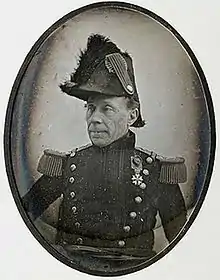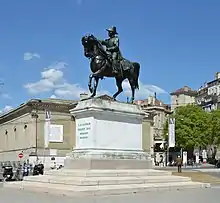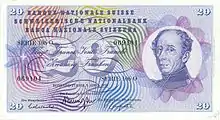Guillaume Henri Dufour
Guillaume Henri Dufour (15 September 1787 – 14 July 1875) was a Swiss army-officer, bridge-engineer and topographer. He served under Napoleon I and held the Swiss office of General four times in his career, firstly in 1847 when he led the Swiss Confederation forces to victory against the Sonderbund. In 1864 Dufour presided over the First Geneva Convention which established the International Red Cross. He was founder and president (1838 to 1865) of the Swiss Federal Office of Topography.
Guillaume Henri Dufour | |
|---|---|
.png.webp) | |
| Born | 15 September 1787 Konstanz, Holy Roman Empire (modern Germany) |
| Died | 14 July 1875 (aged 87) Geneva, Switzerland |
| Allegiance | |
| Service/ | French Army Military of Switzerland |
| Years of service | 1810–1875 |
| Rank | General (France) General (Switzerland) |
| Commands held | Swiss Federal Office of Topography |
| Battles/wars | Defence of Corfu Sonderbund War |
| Awards | Légion d'Honneur |
| Other work | Professor of mathematics, cartographer, founding committee of the International Red Cross |
| Signature | |
Career
Dufour was born in Konstanz,[1] where his parents were temporarily exiled from Geneva. His father Bénédict was a Genevan watchmaker and farmer, who sent his son to school in Geneva, where he studied drawing and medicine. In 1807, Dufour travelled to Paris to join the École Polytechnique, then a military academy. He studied descriptive geometry under Jean Nicolas Pierre Hachette, and graduated fifth in his class in 1809, going on to study military engineering at the École d'Application. In 1810, he was sent to help defend Corfu against the British, and spent his time mapping the island's old fortifications.[1][2]
By 1814, he had returned to France, attained the rank of captain,[2] and was awarded the Croix de la Légion d'Honneur for his work repairing fortifications at Lyons. In 1817, he resumed his status as a Swiss citizen, and returned to Geneva to become commander of the Canton of Geneva's military engineers, as well as a professor of mathematics at the University of Geneva. From 1819 to 1830 he was chief instructor in the military school of Thun, which had been founded mainly through his efforts. Among other distinguished foreign pupils he instructed Louis-Napoleon Bonaparte, nephew of the former Emperor.[3]
In 1827 he was raised to the rank of colonel, and commanded the Federal army in a series of field manoeuvres. In 1831 he became chief of the staff, and soon afterwards he was appointed quartermaster-general. Two years later the Tagsatzung (diet) commissioned him to superintend the execution of a complete trigonometrical survey of Switzerland. He had already made a cadastral survey of the canton of Geneva, and published a map of the canton on the scale of 1⁄25000. The final map in 25 sheets on the scale of 1⁄100000 was published at intervals between 1842 and 1865.[3][1]
In 1847 the Catholic cantons of Switzerland attempted to form a separate alliance of their own, known as the Sonderbund, effectively splitting from the rest of the country. The Tagsatzung appointed Dufour General on 21 October 1847,[4] and he led the federal army of 100,000 and defeated the Sonderbund under Johann-Ulrich von Salis-Soglio in a campaign that lasted only from 3 to 29 November, and claimed fewer than a hundred victims. He ordered his troops to spare the injured. His success, and the moderation with which he treated his vanquished fellow-countrymen, were acknowledged by a gift of 60,000 francs from the Tagsatzung and various honours from different cities and cantons of the confederation.[3]
In addition to serving in the position of General in 1847 due to the Sonderbund War,[4] the Federal Assembly appointed him to the same position in August 1849 due to the Baden Revolution,[5][6] on 27 December 1856 due to the Neuchâtel Crisis,[7] and in 1859 due to the Second Italian War of Independence.[8]
In 1850 the mountaineer and topographer Johann Coaz served as his private secretary.[9]
In 1863 he was part of a committee with Gustave Moynier, Henry Dunant, Louis Appia and Théodore Maunoir that discussed Dunant's ideas for the creation of a voluntary care organization for the assistance of the wounded in battle. Dunant's vision and the committees work ultimately led to the foundation of the International Red Cross. The following year he presided over the international conference which framed the First Geneva Convention as to the treatment of the wounded in time of war.[3]
On 16 July 1875, 60,000 persons participated at Dufour's burial at Cimetière de Plainpalais in Geneva.

Saint Antoine Bridge

Dufour acted as state engineer from 1817, although he was not officially appointed as such until 1828. His work included rebuilding a pumping station, quays and bridges, and he arranged the first steam boat on Lake Geneva as well as the introduction of gas streetlights.[1]
The scientist Marc-Auguste Pictet had visited Marc Seguin's temporary wire-cable simple suspension bridge at Annonay in 1822, the first wire-cable bridge in the world, and published details in Switzerland. He joined with others to promote a new bridge across the Genevan fortifications, consulting with Seguin on how it might be built, receiving back a series of sketches. Dufour developed the design in late 1822, proposing a two-span suspension bridge using wire cables - this would become the first permanent wire cable suspension bridge in the world. The design used three cables on each side of an iron and timber bridge deck.[1] The cables stretched 131 feet between the towers, although the largest span was only 109 feet.[10]
Memorials

Memorials are at:
- Equestrian statue (1884) by Alfred Lanz, at Place de Neuve, Geneva, erected by public subscription[2]
- Two plaques on his birth house at Wessenbergstraße 14 (formerly Plattengasse), Konstanz, Germany [11]
- Plaque at the building where he lived from 1826 to 1845 at Geneva[12]
- Plaque at Château de Montrottier in Lovagny, France [13]
- Plaque at 22, rue Saint-Victor, Carouge, commemorating its use as office of topography.[14]
- Bronze bust, made by Fonderie Leuba, B. Brasseur, succ. at Army Training Center, Lucerne
His home from 1845–1875 at Rue de Contamines, Geneva, is preserved by a foundation.[15][16]
Numerous cities and towns in Switzerland have streets named for him: rue du Général-Dufour in Geneva, La Chaux-de-Fonds; via Gen. Henri Dufour in Chiasso; rue du Général- Dufour/General-Dufour-Strasse in Biel/Bienne; Dufourstrasse in Aarau, Basel, Bern, Biberist, Lenzburg, Luzern, Rorschach, St. Gallen, Thun, Weinfelden, Wettingen, Wil, Zollikon, Zürich; via Dufour in Lugano. There is also Dufourplatz in Zollikon.

The general was depicted on the 20 francs note of the 1956 series of Swiss banknotes (in circulation 1956-1980).[17]
The Dufourspitze (the highest mountain peak in Switzerland) in the Monte Rosa Massif is named after Dufour, to honour his cartographic achievements.[2]
References
- Peters, Tom F., "Transitions in Engineering: Guillaume Henri Dufour and the Early 19th Century Cable Suspension Bridges", Birkhauser, 1987, ISBN 3-7643-1929-1
- Chisholm 1911.
-
 One or more of the preceding sentences incorporates text from a publication now in the public domain: Chisholm, Hugh, ed. (1911). "Dufour, Wilhelm Heinrich". Encyclopædia Britannica. 8 (11th ed.). Cambridge University Press. p. 646.
One or more of the preceding sentences incorporates text from a publication now in the public domain: Chisholm, Hugh, ed. (1911). "Dufour, Wilhelm Heinrich". Encyclopædia Britannica. 8 (11th ed.). Cambridge University Press. p. 646. - Langendorf, Jean-Jacques (7 November 2005). "Dufour, Guillaume-Henri". Historical Dictionary of Switzerland (in German). Retrieved 16 January 2017.
- "ETH - e-periodica". www.e-periodica.ch. Retrieved 11 June 2019.
- Hans Senn: Aktivdienst in German, French and Italian in the online Historical Dictionary of Switzerland.
- Rapport sur l'armement et la campagne de 1857. Revue militaire Suisse 1857
- Toast à la Patrie. Revue militaire Suisse 1860
- Reynolds, Kev, The Swiss Alps , Cicerone, 2012, p. 278.
- Drewry, Charles Stewart, "A Memoir of Suspension Bridges", 1832, online at
- One reads: "Zum Falke: Geburstshaus des berühmten Schweizer Generals Wilhelm Heinrich Dufour (1787–1875). Ermals erwähnt 1428, Im 16. Jh. umgebaut", the other: "Geburtsstätte des Eidgenöss. General Wilh. Heinr. Dufour Geb. den 15. Sept 1787 Gest. in Contamines bei Genf den 14. Juli 1873"
- It includes the text "G.H. Dufour vécut ici de 1826 à 1845"
- The plaque reads "Le château de Montrottier a appartenu à la famille de Guillaume Henri Dufour (15.09.1787-14.07.1875) Capitain du génie sous le 1er Empire, Général pacificateur de la Suisse durant la guerre civile du Sonderbund, cartographe, mathématicien, ingénieur cantonal, cofondateur et 1er Présiduent du Comité international de la Croix-Rouge. Sa famille est copropriétaire du château de Montrottier entre 1799 et 1821 puis unique propriétaire jusqu'à sa vente en 1839 au Baron Jules de Rochette. Plaque apposée à l'initiative de "l'Académie flormontane" et "Les Salons du Général Dufour" Le 30 juin 2012"
- Plaque reads: "En 1838 dans cet immeuble G.H. Dufour Quartier-Maitre Général installa le premier bureau topographique fédéral"
- Fondation pour la conservation de la Maison du Général Guillaume Henri Dufour
- http://www.maison-dufour.ch/bienvenue.php
- "Fifth banknote series (1956)". Swiss National Bank. Retrieved 30 April 2019.
External links
| Wikimedia Commons has media related to Guillaume Henri Dufour. |
- Dufour map in the house of parliament
- Information at Spartacus Schoolnet
- Information at asst.ch (in French)
- Guillaume-Henri Dufour at Structurae
- Obituary at NY Times
- Museum Dufour the only one in the world
- Guillaume Henri Dufour in German, French and Italian in the online Historical Dictionary of Switzerland.